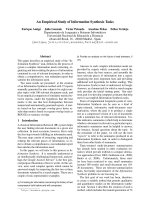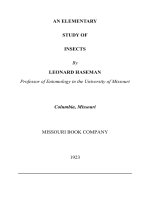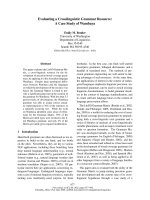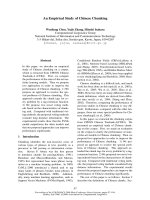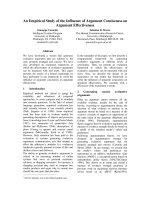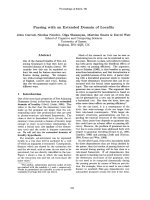AN ELEMENTARY STUDY OF CHEMISTRY pot
Bạn đang xem bản rút gọn của tài liệu. Xem và tải ngay bản đầy đủ của tài liệu tại đây (5.06 MB, 451 trang )
AN ELEMENTARY
STUDY OF CHEMISTRY
BY
WILLIAM McPHERSON, PH.D.
PROFESSOR OF CHEMISTRY, OHIO STATE UNIVERSITY
AND
WILLIAM EDWARDS HENDERSON, PH.D.
ASSOCIATE PROFESSOR OF CHEMISTRY, OHIO STATE UNIVERSITY
REVISED EDITION
GINN & COMPANY
BOSTON * NEW YORK * CHICAGO * LONDON
COPYRIGHT, 1905, 1906, BY
WILLIAM MCPHERSON AND WILLIAM E. HENDERSON
ALL RIGHTS RESERVED
The Athenæum Press
GINN & COMPANY * PROPRIETORS * BOSTON * U.S.A.
Transcriber's note: Minor typos have been corrected.
PREFACE
In offering this book to teachers of elementary chemistry the authors lay no claim to
any great originality. It has been their aim to prepare a text-book constructed along
lines which have become recognized as best suited to an elementary treatment of the
subject. At the same time they have made a consistent effort to make the text clear in
outline, simple in style and language, conservatively modern in point of view, and
thoroughly teachable.
The question as to what shall be included in an elementary text on chemistry is
perhaps the most perplexing one which an author must answer. While an enthusiastic
chemist with a broad understanding of the science is very apt to go beyond the
capacity of the elementary student, the authors of this text, after an experience of
many years, cannot help believing that the tendency has been rather in the other
direction. In many texts no mention at all is made of fundamental laws of chemical
action because their complete presentation is quite beyond the comprehension of the
student, whereas in many cases it is possible to present the essential features of these
laws in a way that will be of real assistance in the understanding of the science. For
example, it is a difficult matter to deduce the law of mass action in any very simple
way; yet the elementary student can readily comprehend that reactions are reversible,
and that the point of equilibrium depends upon, rather simple conditions. The authors
believe that it is worth while to[Pg iv] present such principles in even an elementary
and partial manner because they are of great assistance to the general student, and
because they make a foundation upon which the student who continues his studies to
more advanced courses can securely build.
The authors have no apologies to make for the extent to which they have made use of
the theory of electrolytic dissociation. It is inevitable that in any rapidly developing
science there will be differences of opinion in regard to the value of certain theories.
There can be no question, however, that the outline of the theory of dissociation here
presented is in accord with the views of the very great majority of the chemists of the
present time. Moreover, its introduction to the extent to which the authors have
presented it simplifies rather than increases the difficulties with which the
development of the principles of the science is attended.
The oxygen standard for atomic weights has been adopted throughout the text. The
International Committee, to which is assigned the duty of yearly reporting a revised
list of the atomic weights of the elements, has adopted this standard for their report,
and there is no longer any authority for the older hydrogen standard. The authors do
not believe that the adoption of the oxygen standard introduces any real difficulties in
making perfectly clear the methods by which atomic weights are calculated.
The problems appended to the various chapters have been chosen with a view not only
of fixing the principles developed in the text in the mind of the student, but also of
enabling him to answer such questions as arise in his laboratory work. They are,
therefore, more or less practical in character. It is not necessary that all of them
should[Pg v] be solved, though with few exceptions the lists are not long. The answers
to the questions are not directly given in the text as a rule, but can be inferred from the
statements made. They therefore require independent thought on the part of the
student.
With very few exceptions only such experiments are included in the text as cannot be
easily carried out by the student. It is expected that these will be performed by the
teacher at the lecture table. Directions for laboratory work by the student are published
in a separate volume.
While the authors believe that the most important function of the elementary text is to
develop the principles of the science, they recognize the importance of some
discussion of the practical application of these principles to our everyday life.
Considerable space is therefore devoted to this phase of chemistry. The teacher should
supplement this discussion whenever possible by having the class visit different
factories where chemical processes are employed.
Although this text is now for the first time offered to teachers of elementary
chemistry, it has nevertheless been used by a number of teachers during the past three
years. The present edition has been largely rewritten in the light of the criticisms
offered, and we desire to express our thanks to the many teachers who have helped us
in this respect, especially to Dr. William Lloyd Evans of this laboratory, a teacher of
wide experience, for his continued interest and helpfulness. We also very cordially
solicit correspondence with teachers who may find difficulties or inaccuracies in the
text.
The authors wish to make acknowledgments for the photographs and engravings of
eminent chemists from which[Pg vi] the cuts included in the text were taken; to
Messrs. Elliott and Fry, London, England, for that of Ramsay; to The Macmillan
Company for those of Davy and Dalton, taken from the Century Science Series; to the
L. E. Knott Apparatus Company, Boston, for that of Bunsen.
THE AUTHORS
OHIO STATE UNIVERSITY
COLUMBUS, OHIO
[Pg vii]
CONTENTS
CHAPTER PAGE
I. INTRODUCTION 1
II. OXYGEN 13
III. HYDROGEN 28
IV. WATER AND HYDROGEN DIOXIDE 40
V. THE ATOMIC THEORY 59
VI. CHEMICAL EQUATIONS AND CALCULATIONS 68
VI
I. NITROGEN AND THE RARE ELEMENTS IN THE
ATMOSPHERE
78
VIII. THE ATMOSPHERE 83
IX. SOLUTIONS 94
X. ACIDS, BASES, AND SALTS; NEUTRALIZATION 106
XI. VALENCE 116
XII. COMPOUNDS OF NITROGEN 122
XIII. REVERSIBLE REACTIONS AND CHEMICAL
EQUILIBRIUM
137
XIV. SULPHUR AND ITS COMPOUNDS 143
XV. PERIODIC LAW 165
XVI. THE CHLORINE FAMILY 174
XVII. CARBON AND SOME OF ITS SIMPLER COMPOUNDS 196
XVIII. FLAMES,—ILLUMINANTS 213
XIX.
MOLECULAR WEIGHTS, ATOMIC WEIGHTS,
FORMULAS
223
XX. THE PHOSPHORUS FAMILY 238
XXI. SILICON, TITANIUM, BORON 257
XXII. THE METALS 267
XXIII. THE ALKALI METALS 274
XXIV. THE ALKALINE-EARTH FAMILY 300
XXV. THE MAGNESIUM FAMILY 316
XXVI. THE ALUMINIUM FAMILY 327
XXVII. THE IRON FAMILY 338
XXVIII. COPPER, MERCURY, AND SILVER 356
XXIX. TIN AND LEAD 370
XXX. MANGANESE AND CHROMIUM 379
XXXI. GOLD AND THE PLATINUM FAMILY 390
XXXII. SOME SIMPLE ORGANIC COMPOUNDS 397
INDEX 421
APPENDIX A
Facing back
cover
APPENDIX B
Inside back
cover
[Pg ix]
LIST OF FULL-PAGE ILLUSTRATIONS
PAGE
ANTOINE LAURENT LAVOISIER Frontispiece
JOSEPH PRIESTLEY 14
JOHN DALTON 60
WILLIAM RAMSAY 82
DMITRI IVANOVITCH MENDELÉEFF
166
HENRI MOISSAN 176
SIR HUMPHRY DAVY 276
ROBERT WILHELM BUNSEN 298
[Pg 1]
AN ELEMENTARY STUDY OF CHEMISTRY
CHAPTER I
INTRODUCTION
The natural sciences. Before we advance very far in the study of nature, it becomes
evident that the one large study must be divided into a number of more limited ones
for the convenience of the investigator as well as of the student. These more limited
studies are called the natural sciences.
Since the study of nature is divided in this way for mere convenience, and not because
there is any division in nature itself, it often happens that the different sciences are
very intimately related, and a thorough knowledge of any one of them involves a
considerable acquaintance with several others. Thus the botanist must know
something about animals as well as about plants; the student of human physiology
must know something about physics as well as about the parts of the body.
Intimate relation of chemistry and physics. Physics and chemistry are two sciences
related in this close way, and it is not easy to make a precise distinction between them.
In a general way it may be said that they are both concerned with inanimate matter
rather than with living, and more particularly with the changes which such matter[Pg
2] may be made to undergo. These changes must be considered more closely before a
definition of the two sciences can be given.
Physical changes. One class of changes is not accompanied by an alteration in the
composition of matter. When a lump of coal is broken the pieces do not differ from
the original lump save in size. A rod of iron may be broken into pieces; it may be
magnetized; it may be heated until it glows; it may be melted. In none of these
changes has the composition of the iron been affected. The pieces of iron, the
magnetized iron, the glowing iron, the melted iron, are just as truly iron as was the
original rod. Sugar may be dissolved in water, but neither the sugar nor the water is
changed in composition. The resulting liquid has the sweet taste of sugar; moreover
the water may be evaporated by heating and the sugar recovered unchanged. Such
changes are called physical changes.
DEFINITION: Physical changes are those which do not involve a change in the
composition of the matter.
Chemical changes. Matter may undergo other changes in which its composition is
altered. When a lump of coal is burned ashes and invisible gases are formed which are
entirely different in composition and properties from the original coal. A rod of iron
when exposed to moist air is gradually changed into rust, which is entirely different
from the original iron. When sugar is heated a black substance is formed which is
neither sweet nor soluble in water. Such changes are evidently quite different from the
physical changes just described, for in them new substances are formed in place of the
ones undergoing change. Changes of this kind are called chemical changes.[Pg 3]
DEFINITION: Chemical changes are those which involve a change in the
composition of the matter.
How to distinguish between physical and chemical changes. It is not always easy to
tell to which class a given change belongs, and many cases will require careful
thought on the part of the student. The test question in all cases is, Has the
composition of the substance been changed? Usually this can be answered by a study
of the properties of the substance before and after the change, since a change in
composition is attended by a change in properties. In some cases, however, only a
trained observer can decide the question.
Changes in physical state. One class of physical changes should be noted with
especial care, since it is likely to prove misleading. It is a familiar fact that ice is
changed into water, and water into steam, by heating. Here we have three different
substances,—the solid ice, the liquid water, and the gaseous steam,—the properties of
which differ widely. The chemist can readily show, however, that these three bodies
have exactly the same composition, being composed of the same substances in the
same proportion. Hence the change from one of these substances into another is a
physical change. Many other substances may, under suitable conditions, be changed
from solids into liquids, or from liquids into gases, without change in composition.
Thus butter and wax will melt when heated; alcohol and gasoline will evaporate when
exposed to the air. The three states—solid, liquid, and gas—are called the three
physical states of matter.
Physical and chemical properties. Many properties of a substance can be noted
without causing the substance to undergo chemical change, and are therefore called its
physical properties. Among these are its physical state, color, odor, taste, size, shape,
weight. Other properties are only[Pg 4] discovered when the substance undergoes
chemical change. These are called its chemical properties. Thus we find that coal
burns in air, gunpowder explodes when ignited, milk sours when exposed to air.
Definition of physics and chemistry. It is now possible to make a general distinction
between physics and chemistry.
DEFINITION: Physics is the science which deals with those changes in matter which
do not involve a change in composition.
DEFINITION: Chemistry is the science which deals with those changes in matter
which do involve a change in composition.
Two factors in all changes. In all the changes which matter can undergo, whether
physical or chemical, two factors must be taken into account, namely, energy and
matter.
Energy. It is a familiar fact that certain bodies have the power to do work. Thus water
falling from a height upon a water wheel turns the wheel and in this way does the
work of the mills. Magnetized iron attracts iron to itself and the motion of the iron as
it moves towards the magnet can be made to do work. When coal is burned it causes
the engine to move and transports the loaded cars from place to place. When a body
has this power to do work it is said to possess energy.
Law of conservation of energy. Careful experiments have shown that when one body
parts with its energy the energy is not destroyed but is transferred to another body or
system of bodies. Just as energy cannot be destroyed, neither can it be created. If one
body gains a certain amount of energy, some other body has lost an equivalent
amount.[Pg 5] These facts are summed up in the law of conservation of energy which
may be stated thus: While energy can be changed from one form into another, it
cannot be created or destroyed.
Transformations of energy. Although energy can neither be created nor destroyed, it
is evident that it may assume many different forms. Thus the falling water may turn
the electric generator and produce a current of electricity. The energy lost by the
falling water is thus transformed into the energy of the electric current. This in turn
may be changed into the energy of motion, as when the current is used for propelling
the cars, or into the energy of heat and light, as when it is used for heating and lighting
the cars. Again, the energy of coal may be converted into energy of heat and
subsequently of motion, as when it is used as a fuel in steam engines.
Since the energy possessed by coal only becomes available when the coal is made to
undergo a chemical change, it is sometimes called chemical energy. It is this form of
energy in which we are especially interested in the study of chemistry.
Matter. Matter may be defined as that which occupies space and possesses weight.
Like energy, matter may be changed oftentimes from one form into another; and since
in these transformations all the other physical properties of a substance save weight
are likely to change, the inquiry arises, Does the weight also change? Much careful
experimenting has shown that it does not. The weight of the products formed in any
change in matter always equals the weight of the substances undergoing change.
Law of conservation of matter. The important truth just stated is frequently referred
to as the law of conservation[Pg 6] of matter, and this law may be briefly stated thus:
Matter can neither be created nor destroyed, though it can be changed from one form
into another.
Classification of matter. At first sight there appears to be no limit to the varieties of
matter of which the world is made. For convenience in study we may classify all these
varieties under three heads, namely, mechanical mixtures, chemical compounds, and
elements.
Fig. 1
Mechanical mixtures. If equal bulks of common salt and iron filings are thoroughly
mixed together, a product is obtained which, judging by its appearance, is a new
substance. If it is examined more closely, however, it will be seen to be merely a
mixture of the salt and iron, each of which substances retains its own peculiar
properties. The mixture tastes just like salt; the iron particles can be seen and their
gritty character detected. A magnet rubbed in the mixture draws out the iron just as if
the salt were not there. On the other hand, the salt can be separated from the iron quite
easily. Thus, if several grams of the mixture are placed in a test tube, and the tube half
filled with water and thoroughly shaken, the salt dissolves in the water. The iron
particles can then be filtered from the liquid by pouring the entire mixture upon a
piece of filter paper folded so as to fit into the interior of a funnel (Fig. 1). The paper
retains the solid but allows the clear liquid, known as the filtrate, to drain through. The
iron particles left upon the filter paper will be found to be identical with[Pg 7] the
original iron. The salt can be recovered from the filtrate by evaporation of the water.
To accomplish this the filtrate is poured into a small evaporating dish and gently
heated (Fig. 2) until the water has disappeared, or evaporated. The solid left in the
dish is identical in every way with the original salt. Both the iron and the salt have
thus been recovered in their original condition. It is evident that no new substance has
been formed by rubbing the salt and iron together. The product is called a mechanical
mixture. Such mixtures are very common in nature, almost all minerals, sands, and
soils being examples of this class of substances. It is at once apparent that there is no
law regulating the composition of a mechanical mixture, and no two mixtures are
likely to have exactly the same composition. The ingredients of a mechanical mixture
can usually be separated by mechanical means, such as sifting, sorting, magnetic
attraction, or by dissolving one constituent and leaving the other unchanged.
Fig. 2
DEFINITION: A mechanical mixture is one in which the constituents retain their
original properties, no chemical action having taken place when they were brought
together.
Chemical compounds. If iron filings and powdered sulphur are thoroughly ground
together in a mortar, a yellowish-green substance results. It might easily be taken to be
a new body; but as in the case of the iron and salt, the ingredients can readily be
separated. A magnet draws out the iron. Water does not dissolve the sulphur, but other
liquids do, as, for example, the liquid called carbon disulphide.[Pg 8] When the
mixture is treated with carbon disulphide the iron is left unchanged, and the sulphur
can be obtained again, after filtering off the iron, by evaporating the liquid. The
substance is, therefore, a mechanical mixture.
If now a new portion of the mixture is placed in a dry test tube and carefully heated in
the flame of a Bunsen burner, as shown in Fig. 3, a striking change takes place. The
mixture begins to glow at some point, the glow rapidly extending throughout the
whole mass. If the test tube is now broken and the product examined, it will be found
to be a hard, black, brittle substance, in no way recalling the iron or the sulphur. The
magnet no longer attracts it; carbon disulphide will not dissolve sulphur from it. It is a
new substance with new properties, resulting from the chemical union of iron and
sulphur, and is called iron sulphide. Such substances are called chemical compounds,
and differ from mechanical mixtures in that the substances producing them lose their
own characteristic properties. We shall see later that the two also differ in that the
composition of a chemical compound never varies.
Fig. 3
DEFINITION: A chemical compound is a substance the constituents of which have
lost their own characteristic properties, and which cannot be separated save by a
chemical change.
Elements. It has been seen that iron sulphide is composed of two entirely different
substances,—iron and sulphur. The question arises, Do these substances in turn
contain other substances, that is, are they also chemical compounds?[Pg 9] Chemists
have tried in a great many ways to decompose them, but all their efforts have failed.
Substances which have resisted all efforts to decompose them into other substances
are called elements. It is not always easy to prove that a given substance is really an
element. Some way as yet untried may be successful in decomposing it into other
simpler forms of matter, and the supposed element will then prove to be a compound.
Water, lime, and many other familiar compounds were at one time thought to be
elements.
DEFINITION: An element is a substance which cannot be separated into simpler
substances by any known means.
Kinds of matter. While matter has been grouped in three classes for the purpose of
study, it will be apparent that there are really but two distinct kinds of matter, namely,
compounds and elements. A mechanical mixture is not a third distinct kind of matter,
but is made up of varying quantities of either compounds or elements or both.
Alchemy. In olden times it was thought that some way could be found to change one
element into another, and a great many efforts were made to accomplish this
transformation. Most of these efforts were directed toward changing the commoner
metals into gold, and many fanciful ways for doing this were described. The chemists
of that time were called alchemists, and the art which they practiced was called
alchemy. The alchemists gradually became convinced that the only way common
metals could be changed into gold was by the wonderful power of a magic substance
which they called the philosopher's stone, which would accomplish this
transformation by its mere touch and would in addition give perpetual youth to its
fortunate possessor. No one has ever found such a stone, and no one has succeeded in
changing one metal into another.
Number of elements. The number of substances now considered to be elements is not
large—about eighty in all. Many of these are rare, and very few of them make any[Pg
10] large fraction of the materials in the earth's crust. Clarke gives the following
estimate of the composition of the earth's crust:
Oxygen 47.0% Calcium 3.5%
Silicon 27.9 Magnesium
2.5
Aluminium
8.1 Sodium 2.7
Iron 4.7 Potassium 2.4
Other elements
1.2%
A complete list of the elements is given in the Appendix. In this list the more common
of the elements are marked with an asterisk. It is not necessary to study more than a
third of the total number of elements to gain a very good knowledge of chemistry.
Physical state of the elements. About ten of the elements are gases at ordinary
temperatures. Two—mercury and bromine—are liquids. The others are all solids,
though their melting points vary through wide limits, from cæsium which melts at 26°
to elements which do not melt save in the intense heat of the electric furnace.
Occurrence of the elements. Comparatively few of the elements occur as
uncombined substances in nature, most of them being found in the form of chemical
compounds. When an element does occur by itself, as is the case with gold, we say
that it occurs in the free state or native; when it is combined with other substances in
the form of compounds, we say that it occurs in the combined state, or in combination.
In the latter case there is usually little about the compound to suggest that the element
is present in it; for we have seen that elements lose their own peculiar properties when
they enter into combination with other elements. It would never be suspected, for
example, that the reddish, earthy-looking iron ore contains iron.[Pg 11]
Names of elements. The names given to the elements have been selected in a great
many different ways. (1) Some names are very old and their original meaning is
obscure. Such names are iron, gold, and copper. (2) Many names indicate some
striking physical property of the element. The name bromine, for example, is derived
from a Greek word meaning a stench, referring to the extremely unpleasant odor of
the substance. The name iodine comes from a word meaning violet, alluding to the
beautiful color of iodine vapor. (3) Some names indicate prominent chemical
properties of the elements. Thus, nitrogen means the producer of niter, nitrogen being
a constituent of niter or saltpeter. Hydrogen means water former, signifying its
presence in water. Argon means lazy or inert, the element being so named because of
its inactivity. (4) Other elements are named from countries or localities, as germanium
and scandium.
Symbols. In indicating the elements found in compounds it is inconvenient to use
such long names, and hence chemists have adopted a system of abbreviations. These
abbreviations are known as symbols, each element having a distinctive symbol. (1)
Sometimes the initial letter of the name will suffice to indicate the element. Thus I
stands for iodine, C for carbon. (2) Usually it is necessary to add some other
characteristic letter to the symbol, since several names may begin with the same letter.
Thus C stands for carbon, Cl for chlorine, Cd for cadmium, Ce for cerium, Cb for
columbium. (3) Sometimes the symbol is an abbreviation of the old Latin name. In
this way Fe (ferrum) indicates iron, Cu (cuprum), copper, Au (aurum), gold. The
symbols are included in the list of elements given in the Appendix. They will become
familiar through constant use.[Pg 12]
Chemical affinity the cause of chemical combination. The agency which causes
substances to combine and which holds them together when combined is called
chemical affinity. The experiments described in this chapter, however, show that heat
is often necessary to bring about chemical action. The distinction between the cause
producing chemical action and the circumstances favoring it must be clearly made.
Chemical affinity is always the cause of chemical union. Many agencies may make it
possible for chemical affinity to act by overcoming circumstances which stand in its
way. Among these agencies are heat, light, and electricity. As a rule, solution also
promotes action between two substances. Sometimes these agencies may overcome
chemical attraction and so occasion the decomposition of a compound.
EXERCISES
1. To what class of changes do the following belong? (a) The melting of ice; (b) the
souring of milk; (c) the burning of a candle; (d) the explosion of gunpowder; (e) the
corrosion of metals. What test question must be applied in each of the above cases?
2. Give two additional examples (a) of chemical changes; (b) of physical changes.
3. Is a chemical change always accompanied by a physical change? Is a physical
change always accompanied by a chemical change?
4. Give two or more characteristics of a chemical change.
5. (a) When a given weight of water freezes, does it absorb or evolve heat? (b) When
the resulting ice melts, is the total heat change the same or different from that of
freezing?
6. Give three examples of each of the following: (a) mechanical mixtures; (b)
chemical compounds; (c) elements.
7. Give the derivation of the names of the following elements: thorium, gallium,
selenium, uranium. (Consult dictionary.)
8. Give examples of chemical changes which are produced through the agency of heat;
of light; of electricity.
[Pg 13]
CHAPTER II
OXYGEN
History. The discovery of oxygen is generally attributed to the English chemist
Priestley, who in 1774 obtained the element by heating a compound of mercury and
oxygen, known as red oxide of mercury. It is probable, however, that the Swedish
chemist Scheele had previously obtained it, although an account of his experiments
was not published until 1777. The name oxygen signifies acid former. It was given to
the element by the French chemist Lavoisier, since he believed that all acids owe their
characteristic properties to the presence of oxygen. This view we now know to be
incorrect.
Occurrence. Oxygen is by far the most abundant of all the elements. It occurs both in
the free and in the combined state. In the free state it occurs in the air, 100 volumes of
dry air containing about 21 volumes of oxygen. In the combined state it forms eight
ninths of water and nearly one half of the rocks composing the earth's crust. It is also
an important constituent of the compounds which compose plant and animal tissues;
for example, about 66% by weight of the human body is oxygen.
Preparation. Although oxygen occurs in the free state in the atmosphere, its
separation from the nitrogen and other gases with which it is mixed is such a difficult
matter that in the laboratory it has been found more convenient to prepare it from its
compounds. The most important of the laboratory methods are the following:[Pg 14]
1. Preparation from water. Water is a compound, consisting of 11.18% hydrogen and
88.82% oxygen. It is easily separated into these constituents by passing an electric
current through it under suitable conditions. The process will be described in the
chapter on water. While this method of preparation is a simple one, it is not
economical.
2. Preparation from mercuric oxide. This method is of interest, since it is the one
which led to the discovery of oxygen. The oxide, which consists of 7.4% oxygen and
92.6% mercury, is placed in a small, glass test tube and heated. The compound is in
this way decomposed into mercury which collects on the sides of the glass tube,
forming a silvery mirror, and oxygen which, being a gas, escapes from the tube. The
presence of the oxygen is shown by lighting the end of a splint, extinguishing the
flame and bringing the glowing coal into the mouth of the tube. The oxygen causes the
glowing coal to burst into a flame.
In a similar way oxygen may be obtained from its compounds with some of the other
elements. Thus manganese dioxide, a black compound of manganese and oxygen,
when heated to about 700°, loses one third of its oxygen, while barium dioxide, when
heated, loses one half of its oxygen.
3. Preparation from potassium chlorate (usual laboratory method). Potassium
chlorate is a white solid which consists of 31.9% potassium, 28.9% chlorine, and
39.2% oxygen. When heated it undergoes a series of changes in which all the oxygen
is finally set free, leaving a compound of potassium and chlorine called potassium
chloride. The change may be represented as follows:
/ potassium \ (potassium /potassium \ (potassium
{ chlorine } chlorate) = { } chloride) + oxygen
\ oxygen / \ chlorine /
JOSEPH PRIESTLEY
(English) (1733-1804)
School-teacher, theologian, philosopher, scientist; friend of Benjamin Franklin;
discoverer of oxygen; defender of the phlogiston theory; the first to use mercury in a
pneumatic trough, by which means he first isolated in gaseous form hydrochloric acid,
sulphur dioxide, and ammonia
[Pg 15]
The evolution of the oxygen begins at about 400°. It has been found, however, that if
the potassium chlorate is mixed with about one fourth its weight of manganese
dioxide, the oxygen is given off at a much lower temperature. Just how the manganese
dioxide brings about this result is not definitely known. The amount of oxygen
obtained from a given weight of potassium chlorate is exactly the same whether the
manganese dioxide is present or not. So far as can be detected the manganese dioxide
undergoes no change.
Fig. 4
Directions for preparing oxygen. The manner of preparing oxygen from potassium
chlorate is illustrated in the accompanying diagram (Fig. 4). A mixture consisting of
one part of manganese dioxide and four parts of potassium chlorate is placed in the
flask A and gently heated. The oxygen is evolved and escapes through the tube B. It is
collected by bringing over the end of the tube the mouth of a bottle completely filled
with water and inverted in a vessel of water, as shown in the figure. The gas rises in
the bottle and displaces the water. In the preparation of large quantities of oxygen, a
copper retort (Fig. 5) is often substituted for the glass flask.
Fig. 5
In the preparation of oxygen from potassium chlorate and manganese dioxide, the
materials used must be pure, otherwise a violent explosion may occur. The purity of
the materials is tested by heating a small amount of the mixture in a test tube.
The collection of gases. The method used for collecting oxygen illustrates the general
method used for collecting such gases as are[Pg 16] insoluble in water or nearly so.
The vessel C (Fig. 4), containing the water in which the bottles are inverted, is called a
pneumatic trough.
Commercial methods of preparation. Oxygen can now be purchased stored under
great pressure in strong steel cylinders (Fig. 6). It is prepared either by heating a
mixture of potassium chlorate and manganese dioxide, or by separating it from the
nitrogen and other gases with which it is mixed in the atmosphere. The methods
employed for effecting this separation will be described in subsequent chapters.
Fig. 6
Physical properties. Oxygen is a colorless, odorless, tasteless gas, slightly heavier
than air. One liter of it, measured at a temperature of 0° and under a pressure of one
atmosphere, weighs 1.4285 g., while under similar conditions one liter of air weighs
1.2923 g. It is but slightly soluble in water. Oxygen, like other gases, may be liquefied
by applying very great pressure to the highly cooled gas. When the pressure is
removed the liquid oxygen passes again into the gaseous state, since its boiling point
under ordinary atmospheric pressure is -182.5°.
Chemical properties. At ordinary temperatures oxygen is not very active chemically.
Most substances are either not at all affected by it, or the action is so slow as to escape
notice. At higher temperatures, however, it is very active, and unites directly with
most of the elements. This activity may be shown by heating various substances until
just ignited and then bringing them into vessels of the gas, when they will burn with
great brilliancy. Thus a glowing splint introduced into a jar of oxygen bursts into
flame. Sulphur burns in the air with a very weak flame and feeble light; in oxygen,
however, the flame is increased in size and[Pg 17] brightness. Substances which
readily burn in air, such as phosphorus, burn in oxygen with dazzling brilliancy. Even
substances which burn in air with great difficulty, such as iron, readily burn in
oxygen.
The burning of a substance in oxygen is due to the rapid combination of the substance
or of the elements composing it with the oxygen. Thus, when sulphur burns both the
oxygen and sulphur disappear as such and there is formed a compound of the two,
which is an invisible gas, having the characteristic odor of burning sulphur. Similarly,
phosphorus on burning forms a white solid compound of phosphorus and oxygen,
while iron forms a reddish-black compound of iron and oxygen.
Oxidation. The term oxidation is applied to the chemical change which takes place
when a substance, or one of its constituent parts, combines with oxygen. This process
may take place rapidly, as in the burning of phosphorus, or slowly, as in the oxidation
(or rusting) of iron when exposed to the air. It is always accompanied by the liberation
of heat. The amount of heat liberated by the oxidation of a definite weight of any
given substance is always the same, being entirely independent of the rapidity of the
process. If the oxidation takes place slowly, the heat is generated so slowly that it is
difficult to detect it. If the oxidation takes place rapidly, however, the heat is
generated in such a short interval of time that the substance may become white hot or
burst into a flame.
Combustion; kindling temperature. When oxidation takes place so rapidly that the
heat generated is sufficient to cause the substance to glow or burst into a flame the
process is called combustion. In order that any substance may undergo combustion, it
is necessary that it should be[Pg 18] heated to a certain temperature, known as the
kindling temperature. This temperature varies widely for different bodies, but is
always definite for the same body. Thus the kindling temperature of phosphorus is far
lower than that of iron, but is definite for each. When any portion of a substance is
heated until it begins to burn the combustion will continue without the further
application of heat, provided the heat generated by the process is sufficient to bring
other parts of the substance to the kindling temperature. On the other hand, if the heat
generated is not sufficient to maintain the kindling temperature, combustion ceases.
Oxides. The compounds formed by the oxidation of any element are called oxides.
Thus in the combustion of sulphur, phosphorus, and iron, the compounds formed are
called respectively oxide of sulphur, oxide of phosphorus, and oxide of iron. In
general, then, an oxide is a compound of oxygen with another element. A great many
substances of this class are known; in fact, the oxides of all the common elements
have been prepared, with the exception of those of fluorine and bromine. Some of
these are familiar compounds. Water, for example, is an oxide of hydrogen, and lime
an oxide of the metal calcium.
Products of combustion. The particular oxides formed by the combustion of any
substance are called products of combustion of that substance. Thus oxide of sulphur
is the product of the combustion of sulphur; oxide of iron is the product of the
combustion of iron. It is evident that the products of the combustion of any substance
must weigh more than the original substance, the increase in weight corresponding to
the amount of oxygen taken up in the act of combustion. For example, when iron
burns the oxide of iron formed weighs more than the original iron.[Pg 19]
In some cases the products of combustion are invisible gases, so that the substance
undergoing combustion is apparently destroyed. Thus, when a candle burns it is
consumed, and so far as the eye can judge nothing is formed during combustion. That
invisible gases are formed, however, and that the weight of these is greater than the
weight of the candle may be shown by the following experiment.
Fig. 7
A lamp chimney is filled with sticks of the compound known as sodium hydroxide
(caustic soda), and suspended from the beam of the balance, as shown in Fig. 7. A
piece of candle is placed on the balance pan so that the wick comes just below the
chimney, and the balance is brought to a level by adding weights to the other pan. The
candle is then lighted. The products formed pass up through the chimney and are
absorbed by the sodium hydroxide. Although the candle burns away, the pan upon
which it rests slowly sinks, showing that the combustion is attended by an increase in
weight.
Combustion in air and in oxygen. Combustion in air and in oxygen differs only in
rapidity, the products formed being exactly the same. That the process should take
place less rapidly in the former is readily understood, for the air is only about one fifth
oxygen, the remaining four fifths being inert gases. Not only is less oxygen available,
but much of the heat is absorbed in raising the temperature of the inert gases
surrounding the substance undergoing combustion, and the temperature reached in the
combustion is therefore less.
Phlogiston theory of combustion. The French chemist Lavoisier (1743-1794), who
gave to oxygen its name was the first to show that combustion is due to union with


